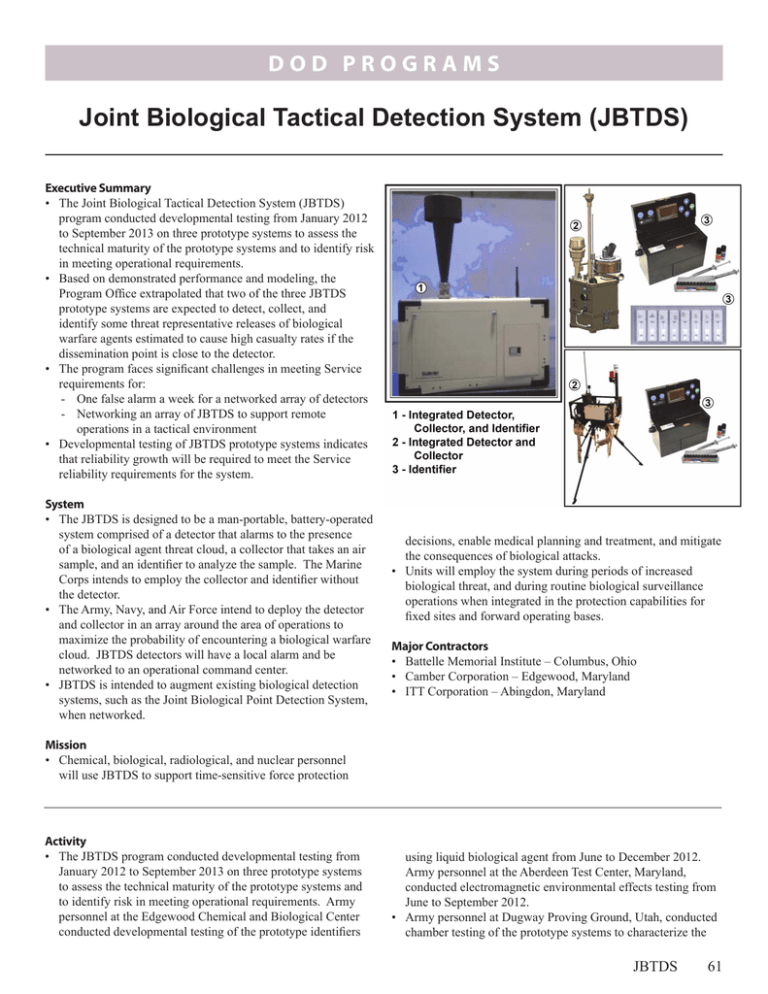Joint Biological Tactical Detection System (JBTDS)
advertisement

DOD PROGRAMS Joint Biological Tactical Detection System (JBTDS) Executive Summary • The Joint Biological Tactical Detection System (JBTDS) program conducted developmental testing from January 2012 to September 2013 on three prototype systems to assess the technical maturity of the prototype systems and to identify risk in meeting operational requirements. • Based on demonstrated performance and modeling, the Program Office extrapolated that two of the three JBTDS prototype systems are expected to detect, collect, and identify some threat representative releases of biological warfare agents estimated to cause high casualty rates if the dissemination point is close to the detector. • The program faces significant challenges in meeting Service requirements for: - One false alarm a week for a networked array of detectors - Networking an array of JBTDS to support remote operations in a tactical environment • Developmental testing of JBTDS prototype systems indicates that reliability growth will be required to meet the Service reliability requirements for the system. System • The JBTDS is designed to be a man-portable, battery-operated system comprised of a detector that alarms to the presence of a biological agent threat cloud, a collector that takes an air sample, and an identifier to analyze the sample. The Marine Corps intends to employ the collector and identifier without the detector. • The Army, Navy, and Air Force intend to deploy the detector and collector in an array around the area of operations to maximize the probability of encountering a biological warfare cloud. JBTDS detectors will have a local alarm and be networked to an operational command center. • JBTDS is intended to augment existing biological detection systems, such as the Joint Biological Point Detection System, when networked. decisions, enable medical planning and treatment, and mitigate the consequences of biological attacks. • Units will employ the system during periods of increased biological threat, and during routine biological surveillance operations when integrated in the protection capabilities for fixed sites and forward operating bases. Major Contractors • Battelle Memorial Institute ‒ Columbus, Ohio • Camber Corporation ‒ Edgewood, Maryland • ITT Corporation ‒ Abingdon, Maryland Mission • Chemical, biological, radiological, and nuclear personnel will use JBTDS to support time-sensitive force protection Activity • The JBTDS program conducted developmental testing from January 2012 to September 2013 on three prototype systems to assess the technical maturity of the prototype systems and to identify risk in meeting operational requirements. Army personnel at the Edgewood Chemical and Biological Center conducted developmental testing of the prototype identifiers using liquid biological agent from June to December 2012. Army personnel at the Aberdeen Test Center, Maryland, conducted electromagnetic environmental effects testing from June to September 2012. • Army personnel at Dugway Proving Ground, Utah, conducted chamber testing of the prototype systems to characterize the JBTDS 61 DOD PROGRAMS performance of the integrated detector, collector, and identifier against four classes of biological warfare agents from January to May 2013. Army personnel conducted detector testing to determine if the presence of common battlefield interferents would cause the detectors to false alarm. • The Program Office tested the prototype systems’ capability to be remotely operated over a network and the propensity of the detectors to alarm when no biological warfare agent threat is present. Testing was conducted at Edgewood, Maryland, from April 17 through May 14, 2012. Aberdeen Test Center personnel conducted tests on the capability of the prototype systems to operate in an extreme operating environment June 18 through September 7, 2012. • The Program Office funded the Institute for Defense Analyses to use demonstrated performance data to model the ability of a unit equipped with the JBTDS to mitigate casualties from a range of biological warfare agent attacks. Assessment • Based on demonstrated performance and modeling, the Program Office extrapolated that two of the three JBTDS prototype systems are expected to detect, collect, and identify some threat representative releases of biological warfare agents estimated to cause high casualty rates if the dissemination point is close to the detector. • The JBTDS prototype systems demonstrated the required 90 percent probability to detect 3 of 4 biological warfare agent classes and 5 of 8 agent preparations at concentrations expected to cause significant casualties. • The JBTDS prototype collection technology is mature and in operational use today. • Prototype identification technologies demonstrated the capability to identify three of the four agent classes at concentrations that are estimated to result in significant casualties. For one of the three agent classes, the capability was dependent upon how the agent was prepared. • The program faces a significant challenge in meeting the Service-defined requirement of one false alarm a week for a 62 JBTDS networked array of detectors. This equates to 168 hours mean time between detector false alarms for a networked array of multiple JBTDSs. JBTDS prototype systems demonstrated a mean time between detector false alarms between 30 and 97 hours for a single system. • The program faces a substantial challenge in networking an array of JBTDSs to support remote operations in a tactical environment. Two of the JBTDS prototype systems demonstrated basic capability to send alert notifications to a base station and remotely trigger collection of an aerosol sample using a commercial wireless network during testing in Edgewood, Maryland. • Developmental testing of JBTDS prototype systems indicates that reliability growth will be required to meet the Service operational reliability requirements for the system. Combined detector and collector prototype reliability ranged from 176 to 531 hours at the 80 percent lower confidence bound in comparison to the operational requirement of 480 hours. Identifier prototype reliability ranged from 109 to 202 hours at the 80 percent lower confidence bound. The operational requirement is 150 hours. Recommendations • Status of Previous Recommendations. This is the first annual report for this program. • FY13 Recommendations. The program should: 1. Invest in technology development to improve detector component sensitivity and false alarm rate. 2. Develop or leverage development of more sensitive identification technologies for two of the three agent classes. 3. Begin operational network capability development and testing early in the Engineering and Manufacturing Development phase of the program. 4. Institute a reliability growth program after award of an Engineering and Manufacturing Development contract.







